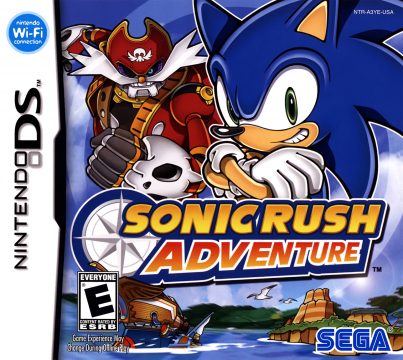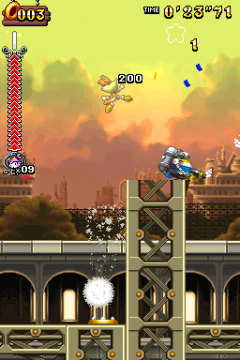- Sonic Generations
- Sonic the Hedgehog
- Sonic the Hedgehog 2
- Sonic CD
- Sonic the Hedgehog 3
- Sonic & Knuckles
- Sonic the Hedgehog 4
- Sonic Mania
- SegaSonic The Hedgehog
- Sonic The Fighters
- Sonic 3D Blast
- Knuckles’ Chaotix
- SegaSonic Bros.
- Sonic the Hedgehog (8-bit)
- Sonic the Hedgehog 2 (8-bit)
- Sonic Chaos
- Sonic the Hedgehog Triple Trouble
- Tails’ Skypatrol
- Tails Adventures
- Sonic Labyrinth
- Sonic Drift
- Sonic Drift 2
- Sonic Blast
- Sonic R
- Murder of Sonic the Hedgehog, The
- Sonic Advance
- Sonic Advance 2
- Sonic Advance 3
- Sonic Rush
- Sonic Rush Adventure

American Cover
Sonic Rush Adventure is noteworthy for being the last unique handheld Sonic co-developed by Dimps, before they began making companion versions of the main games. It’s also noteworthy for being a shockingly ambitious sequel, keeping the same gameplay but placing it within a huge sea-faring adventure (inspired by director Sakae Osumi’s fondness for such stories) where you explore the ocean, fight pirates, and discover all sorts of things. That it does all this while refining the Rush style to create a more welcoming and consistent sequel makes for an admirable send-off to Dimps’ original efforts.
Sonic and Tails are out looking for strange energy readings, when they get caught up in a terrible storm. They find themselves washed ashore on an island in the middle of an endless sea, rescued by a young impulsive raccoon named Marine who dreams of adventure. Using Tails’ ingenuity and strange materials found on the island, they build a capable craft and start to explore the ocean, where they discover more islands, a band of robotic pirates looking for an artefact, and even an old friend…
The story has much more prominence than before, full of surprisingly long cutscenes that feature some degree of plot progression but are largely character-driven. The writing’s got a good deal of snappiness, leading to plenty of charming conversations where everyone’s distinct personalities – especially Marine’s headstrong cockiness – take center-stage. You can skip the cutscenes if you want, but it’s a likeable adventure that has a lot of fun with itself.
Rush Adventure carries over the same gameplay from its predecessor, asking you to reach the end of the level while pulling off tricks to build up your ability to boost at top speeds and through enemies. Although she isn’t available at first, you’ll soon unlock Blaze and be able to choose between her and Sonic at the start of each zone. A minor but welcome tweak is that you can now perform tricks on the grind rails by pressing B, cutting down on those instances where you’d accidentally jump off them while performing aerial tricks. You thankfully have only one campaign to play through, because it’s considerably more expansive thanks to the new structure.
Every zone is an island on the sea that can only be reached by some sort of seacraft, which can be built by gathering enough materials found in each zone. These are awarded once you reach the end of a level, and you get more materials the higher your rank is, so you’re encouraged to revisit and master levels if you want to find materials quickly. A nice touch is that you can replay discovered stages from the menu, cutting down on unnecessary sailing.
Exploring the sea almost exclusively uses the touchscreen, such as charting your route and directly controlling the four vehicles you build. Each one has unique capabilities so you’ll need to consider carefully before you set out. You start with the Wave Cyclone, a water bike which races along shallow waters; the Ocean Tornado is an armed ship that can explore further shores but has to defend itself from enemy fire; the Aqua Blast is a speedy hovercraft that controls much like the Wave Cyclone and can shoot and deflect bullets; and the Deep Typhoon is a submarine where you can discover underwater entrances after blasting enemies via a rhythm-action minigame.
These sections are snappily paced and don’t overwhelm the player with touchscreen inputs (you can swap the Tornado’s weapons or boost on the Cyclone with buttons), so they keep things interesting as you explore the seas. Rush Adventure generally works very well for casual handheld play, where you can play for a few minutes and make some kind of progress – playing levels, exploring the sea, discovering small islands with brief challenges to complete, and gathering materials.
This also extends to your homebase at Southern Island. Here, you can ask Tails to build vehicles, manually save your game (please remember this since there’s no autosave function), chart the route to your next destination, play time attack for both the regular and sea-faring stages, and take on various side missions via NPCs who soon populate the place. Most of these are quick optional challenges that give you bonus rewards such as island decorations and the ability to view cutscenes, but there’s a handful (requested by Blaze’s attendant) that you must be beat to acquire the Sol Emeralds.
Like with Rush, you’ll need all of the Chaos and Sol Emeralds to see the true ending. Chaos Emeralds are won by racing against Johnny, a notorious speedster found jet-skiing in remote areas. They start easy enough but get increasingly difficult as Johnny’s speed picks up and he starts attacking you. In fact, they’re too difficult, because you only have a decent shot of beating the later races once you upgrade the Wave Cyclone, which is something you can’t do until you’ve beaten the regular final boss and can replay the last zone to acquire its special materials.
The material requirements for building vehicles goes up overtime, and especially so for upgrading them, so you’ll need to replay stages repeatedly if you want to get anywhere. While the game is good for letting you make progress in brief spurts, its overall structure can sometimes become bloated and repetitive if you’re playing long sessions or want to get straight to the main stages. Thankfully, those main stages are quite the treat thanks to a huge improvement in level design.
While they’re nowhere near as challenging as Rush, that’s largely because they’ve eschewed much of the momentum-breaking nonsense. Forced combat sections are entirely gone, setpieces are much quicker and require some skill to overcome, crushers and lethal areas don’t appear until the final stages, and the overall flow of the designs allows you to achieve and maintain boost much more elegantly. There are some points where you’ll unknowingly go too far over areas where setpieces are meant to trigger and die, but stages are consistently a blast to play through.
The bosses are also much better, with a variety of memorable encounters that give you more opportunities to attack them. There’s thankfully no insta-kill attacks, making them enjoyable scrappy fights to cap off each zone. Like before, you can choose between easy and normal difficulty levels to affect the complexity of boss fights, but it’s manageable either way.
There isn’t much to say about Rush Adventure‘s graphics technically, since they retain the previous game’s mix of 3D and 2D elements. The sea-faring sections are entirely in 3D and have a lower framerate as a result, though it’s responsive to the touchscreen controls so it isn’t a problem. The major islands are distinct from each other, indulging in memorable themes like an underwater cave full of gems, an island made entirely out of metal, and a haunted graveyard of abandoned ships.
Although Hideki Naganuma didn’t return to compose the music (as he was busy with Ryu ga Gotoku Kurohyou), the soundtrack by Tomoya Ohtani, Seirou Okamoto, and Mariko Nanba does an admirable job at emulating Sonic Rush‘s style of vocal samples and distinct chord progressions while going in its own direction. There’s more tropical instrumentation such as acoustic guitars and steel drums, and the arrangements aren’t as intense or abrasive which fits nicely with the light-hearted vibes.
Partially due to the game’s unique setting, Marine and the other characters don’t appear often in other Sonic media. They fit right at home in the dimension-hopping adventures of the Archie comics, appearing in a few issues before taking center-stage in Sonic Universe‘s “Pirate Plunder Panic” (issues #55-58). Marine has also briefly shown up in the IDW comic, primarily the “Guardians” story of the 2022 Annual, in addition to a handful of monthly short stories published on the Sonic Channel website.
SOURCES:
A translation of a Sonic Channel interview from 2007 with Rush Adventure‘s director Sakae Osumi – https://browniehideout.wordpress.com/2022/07/24/creators-interview-018-oosumi-sakae/


